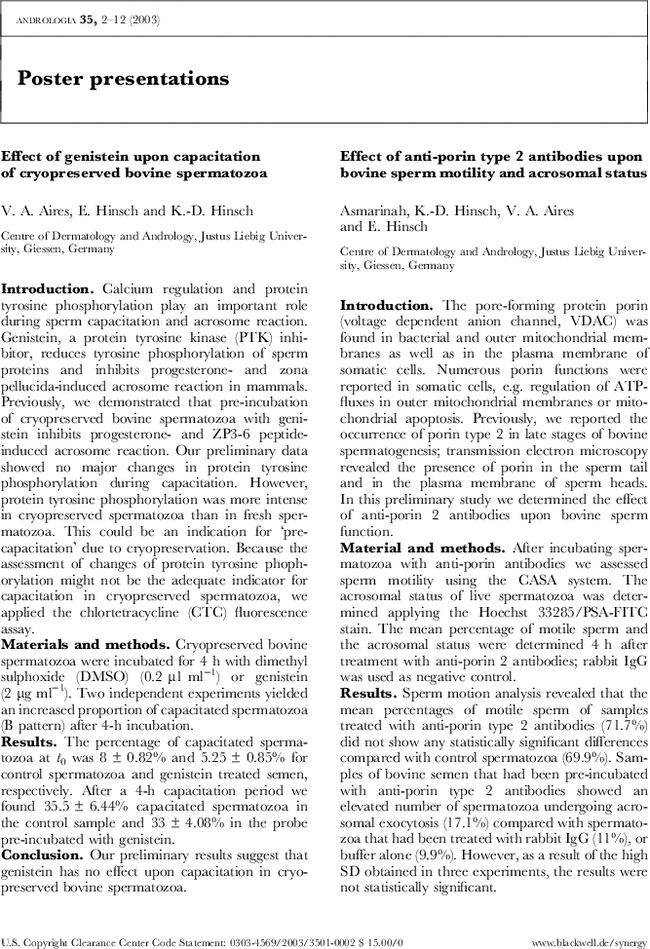Frequent DAZ1/DAZ2 deletions in men with severe oligozoospermia
S. Fernandes
Institute of Human Genetics, University of Heidelberg, Germany;
S Genética, F.M. Porto, Portugal;
Search for more papers by this authorK. Hüllen
Institute of Human Genetics, University of Heidelberg, Germany;
Search for more papers by this authorJ. Zeisler
Institute of Human Genetics, University of Heidelberg, Germany;
Search for more papers by this authorE. Rajpert De Meyts
Department of Growth and Reproduction, Rigshospitalet, University of Copenhagen, Denmark;
Search for more papers by this authorN. E. Skakkebaek
Department of Growth and Reproduction, Rigshospitalet, University of Copenhagen, Denmark;
Search for more papers by this authorB. Habermann
Department of Andrology, University of Marburg, Germany
Search for more papers by this authorW. Krause
Department of Andrology, University of Marburg, Germany
Search for more papers by this authorP. H. Vogt
Institute of Human Genetics, University of Heidelberg, Germany;
Search for more papers by this authorS. Fernandes
Institute of Human Genetics, University of Heidelberg, Germany;
S Genética, F.M. Porto, Portugal;
Search for more papers by this authorK. Hüllen
Institute of Human Genetics, University of Heidelberg, Germany;
Search for more papers by this authorJ. Zeisler
Institute of Human Genetics, University of Heidelberg, Germany;
Search for more papers by this authorE. Rajpert De Meyts
Department of Growth and Reproduction, Rigshospitalet, University of Copenhagen, Denmark;
Search for more papers by this authorN. E. Skakkebaek
Department of Growth and Reproduction, Rigshospitalet, University of Copenhagen, Denmark;
Search for more papers by this authorB. Habermann
Department of Andrology, University of Marburg, Germany
Search for more papers by this authorW. Krause
Department of Andrology, University of Marburg, Germany
Search for more papers by this authorP. H. Vogt
Institute of Human Genetics, University of Heidelberg, Germany;
Search for more papers by this author
References
- Fernandes S, Huellen K, Goncalves J, Dukal H, Zeisler J, Rajpert De Meyts E, Skakkebaek NE, Habermann B, Krause W, Sousa M, Barros A, Vogt PH (2002) High frequency of DAZ1/DAZ2 gene deletions in patients with severe oligozoospermia. Mol Hum Reprod 8: 286 – 298.
- Glaser B, Yen PH, Schempp W (1998) Fibre-fluorescence in situ hybridization unravewls apparently seven DAZ genes or pseudogenes clustered within a Y-chromosome region frequently deleted in azoospermic males. Chromosome Res 6: 481 – 186.
- Saxena R, de Vries JW, Repping S, Alagappan RK, Skaletsky H, Brown LG, Ma P, Chen E, Hoovers JM, Page DC (2000) Four DAZ genes in two clusters found in the AZFc region of the human Y chromosome. Genomics 67: 256 – 267.
- Vogt PH, Edelmann A, Kirsch S, Henegariu O, Hirchmann P, Kiesewetter F, Köhn FM, Schill WB, Farah S, Ramos C, Hartmann M, Hartschuh W, Meschede D, Behre HM, Castel A, Nieschlag E, Weidner W, Grone HJ, Jung A, Engel W, Haidl G (1996) Human Y chromosome azoospermia factors (AZF) mapped to different subregions in Yq11. Hum Mol Genet 5: 933 – 943.
- Yen PH, Chai NN, Salido EC (1997) The human DAZ genes, a putative male infertility factor on the Y chromosome, are highly polymorphic in the DAZ repeat regions. Mamm Genome 8: 756 – 759.




